Writing Universal History in the Fifteenth Century: Introducing H(istoires) U(niverselles) 15
In this new blog post, we have invited Anne Salamon to tell us about her research project funded by the Social Sciences and Humanities Research Council on universal chronicles in French from the 15th century: H(istoires) U(niverselles) en français au XVe siècle (2018-2023). Anne is assistant professor of Romance Philology at the University of British Columbia.
When considering the different collections of edited texts in Old French, historically there has been an emphasis on the oldest texts, and on certain genres, mainly lyric poetry and romance, for example. But when we venture into didactic literature, especially that of a compilatory nature, the situation is more uneven. Universal chronicles in the vernacular, and especially in French, have elicited more and more interest in the last decade, and much work has been done to shed light on some of their earliest examples. However, this is where another bias comes into play as far as late medieval texts are concerned: because of their compilatory nature, they arouse less interest than similar but older texts from medievalists, and when they don’t reflect emerging humanism, they are of little interest to scholars focused on the Early Modern period, which is why they fall between the cracks of traditional disciplinary divides.
Very often, even for the oldest texts, more than the obvious lack of editions, it is also the lack of insight into the evolution of these texts over the decades, or even centuries, that proves troublesome, something I experienced while I was working on the Traité des Neuf Preux et des Neuf Preuses by Sébastien Mamerot, a text from the end of the 15th century. Sébastien Mamerot, far from only writing simple biographies of the nine heroes and heroines, includes them in a narrative with a deeper chronological perspective, digressing so much at times that each section looks like an excerpt from a universal chronicle. In such circumstances, the difficulty was to identify the source material for these expanded genealogies and narratives. The situation is complex for 15th century authors, who can choose from three paths for selecting their material: for those with knowledge of Latin sources, these texts continue to offer viable references, whether historical texts in medieval Latin, classical texts, or more recent Italian compositions, for example; translations of these Latin sources are also common, as is for example Laurent de Premierfait’s translation of Vincent of Beauvais; and finally, the universal chronicles in French from the 13th and 14th centuries are also still copied, and many libraries hold a version of the Histoire ancienne jusqu’à César, the Chronique dite de Baudouin d’Avesnes or the Manuel d’histoire dit de Philippe VI de Valois. Considering the amount of rewriting involved as well as the modernisation of language common in these 15th century texts, identifying the exact intermediary can be a tricky process given the lack of research: very often, even if it is possible to accurately identify a source, the search for the exemplar that might have been used must be abandoned: earlier manuscripts are used for the edition and critical apparatus, leaving a very large number of manuscripts unknown in their details.
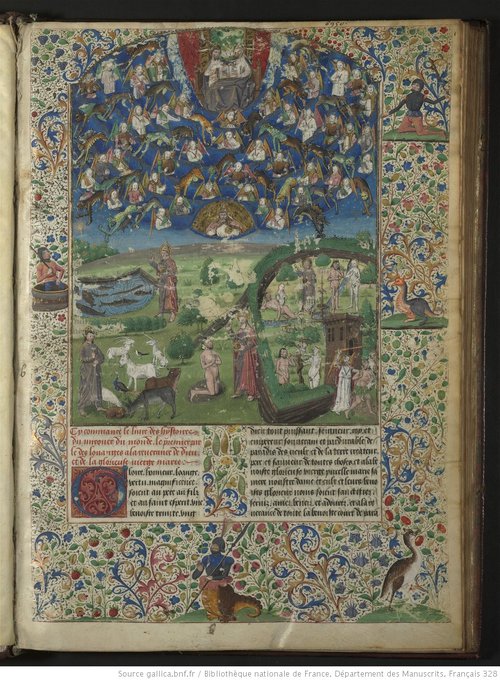
Le Livre des histoires du miroer du monde: BnF, français 328, fol. 1r. Source: Gallica
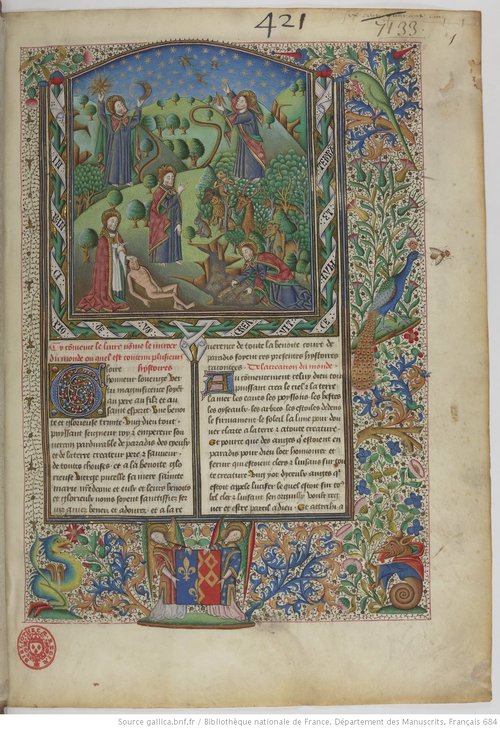
Le Livre des histoires du miroer du monde: BnF, français 684, fol. 1r. Source: Gallica
The answer to this problem lies in two directions: the first is to develop research on more recent versions of the oldest texts, in order to highlight their mutations, as recent research has proved it was a genre very commonly subjected to rewriting, interferences and contaminations; the second is to gain a better knowledge of the general layout of the universal chronicles to see what contents they share and how they differ from one another. A very good example of this first avenue of new research is showcased by the work done on the Histoire ancienne jusqu’à César by TVOF and other scholars. The idea of a fourth redaction, proposed by Jeffrey H. Kaimowitz, has for example been rejected by Anne Rochebouet, who demonstrates that the link to the original HAC is too tenuous to consider it a fourth redaction: she argues that the constant rewriting and remodeling of the oldest texts make for complex situations where 15th century production is concerned. Richard Trachsler notes that the New York manuscript is in fact part of a large compilation that has gone for the most part unnoticed. The work of Marigold Anne Norbye on A tous nobles shows the same mechanics: she identifies about 65 manuscripts of the text in over twenty versions, transmitted alone, including in an abridged universal chronicle or a fully developed one.
The second path is the one I have chosen to explore with my research project on universal chronicles from the 15th century (visit the website here). Next to well-known texts like the Bouquechardière by Jean de Courcy or La Fleur des histoires by Jean Mansel, two texts that benefit from some critical interest, manuscript databases and catalogs bring up a whole nebula of texts with similar titles, usually haphazardly given for cataloguing needs (e.g. Chronique, Chronique universelle, Chronique anonyme universelle, Chronologie universelle jusqu’à la mort de Charles VI, Chroniques et histoires saintes et profanes depuis la création du monde, Compilation historique, Chronique universelle de la Création à Charles vii, Chronique universelle de la création à Louis XII, etc.), and uncertain contents, whose relationships are difficult to intuit at a glance. One of the aims of the HU15 project is to offer an entry point to allow a quick comparison and serial overview of comparable texts often only considered on their own.
One such book, Le Livre des histoires du miroer du monde, is anonymous and dated, based on the known manuscripts, to the second half of the 15th century. The difficulties surrounding this text give a good sample of the challenges posed by the large mass of unedited vernacular chronicles from the end of the Middle Ages. Piotr Tylus produced the only analysis of this text when he discovered an additional manuscript at the Jagiellonian Library in Krakow.
The first typical element that this text shares with many other unedited chronicles of the 15th century is the difficulty in differentiating the versions. Sometimes simply called the Miroer du monde, this text must not be confused with the Miroir du monde linked to the Somme le Roi by Frère Laurent. Establishing the list of witnesses is also made harder by the fact that the print version is often catalogued as a translation of the Miroir historial by Vincent de Beauvais and by the fact that the text shares its incipit with two other universal chronicles, the Chronique universelle abrégée de la Création jusqu'à Louis XI and the Chronique universelle de la Création à Charles VII (the titles are those given by the IRHT in JONAS). This last text contains the genealogical text A tous nobles named earlier, but the exact relationship between all of these texts still eludes us for lack of philological data.
The second typical element about the Livre du miroer des histoires du monde is the fact that although it is quite faithful to older texts, it presents a specific structure that remodels the known material, although this restructuration doesn’t go as far as the better known Fleur des histoires or Bouquechardière. History, in the Livre du miroer des histoires du monde, is structured around two periods, a “time of turning away” and a “time of coming back” which refer to the times after the Fall of Adam until the time of Moses and the flight from Egypt, when the second period starts:
Et pour ce que nous avons parlé en nostre premier livre du temps de desvoiement maintenant commencerons le second livre qui parle du temps de rappellement, en ensuivant nostre premier matiere jusques en fin…(BnF, fr. 9686, fol. 12v)
As mentioned earlier, and as with older texts like the Chronique dite de Baudouin d’Avesnes or the Histoire ancienne, it is not uncommon to find different versions of the same text, to the point where one can wonder when a text counts as new or is still a version of the original. Despite a small number of manuscripts, Le Livre des histoires du miroer du monde can be divided into three families, with noticeable variations: ms. Oxford, Bodleian Library, Douce, 336-337 seems to be the oldest and presents a sometimes lengthier text; there is then a second group of manuscripts (BnF, français 328, 684 and 9686, as well as Berlin-Krakow, Staatsbibliothek zu Berlin-Preussischer Kulturbesitz-Biblioteka Jagiellonska, gall. f° 0129), maybe from the region of the Val-de-Loire, and lastly Chantilly, Bibliothèque du Château (musée Condé), 723, which presents a text close to that of the print version. Only a systematic and more in-depth philological analysis could refine this very preliminary overview. However, ms. fr. 684 deserves more attention as it has a fully divergent text, first only in certain paragraphs, and then continuously.
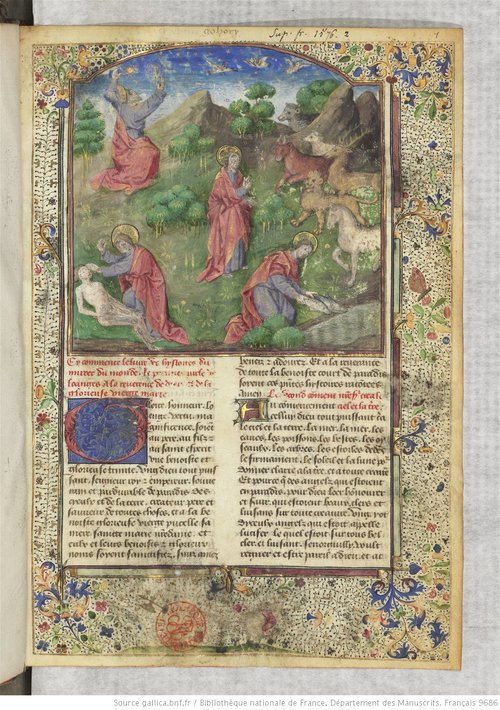
Le Livre des histoires du miroer du monde: BnF, français 9686, fol. 1r. Source: Gallica
This brings us to a last common point of many 15th-century universal chronicles in French – the way in which they use older vernacular sources, alone or in conjunction with Latin ones. I am of course deliberately setting aside chronicles that are direct and self-proclaimed translations of Latin texts, as the behaviour of these texts is somewhat different, and they are usually easier to apprehend as translations. The Histoire ancienne, the Chronique dite de Baudouin d’Avesnes and the Manuel d’histoire dit de Philippe VI de Valois are very common building blocks in several historical compilations (and later copies of the three texts present interpolations of the others in ways that haven’t fully been studied yet).
As an example, here is the beginning of King Cyrus’s story; the origin of the historical data is the Historia scholastica. The following passages explain how a daughter was born to Astyages and he saw in a dream that from his daughter’s womb a vine grew that covered all of Asia. He then learned from the dream interpreters that he would have a grandson from his daughter, who would rule over Asia and expel him from his realm:
Porro Astyages unicam habuit filiam, et vidit somnium, quod de genitalibus filiae oriebatur vitis, quae totam occupabat Asiam, et accepit a conjectoribus se habiturum nepotem ex filia, qui dominus esset Asiae, et ipsum dejiceret a regno.
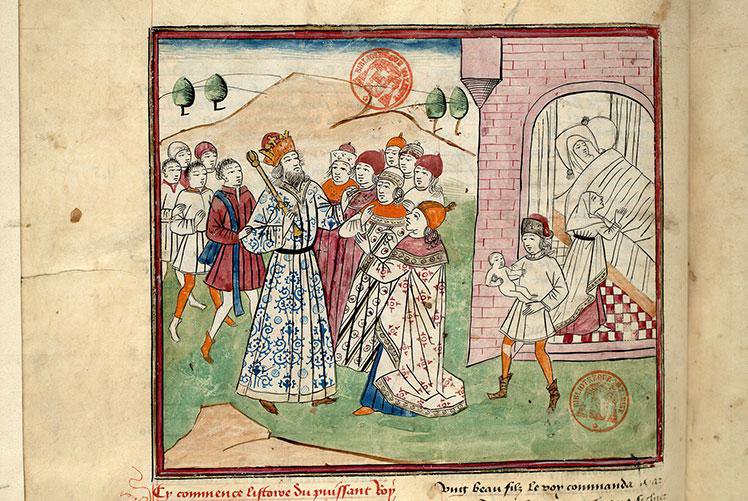
Jean Mansel, Fleur des Histoires : Mazarine, 1559, fol. 124v. Source: BVMM
This same excerpt was chosen by Vincent de Beauvais for his Speculum historiale. Taken individually, it is impossible to identify whether the following excerpts used the Historia scholastica or the Speculum historiale as their source. But from larger comparisons, we can work out that while the Histoire ancienne follows Petrus Comestor, the Chronique dite de Baudouin d’Avesnes and the Manuel d’histoire dit de Philippe VI de Valois are based on Vincent de Beauvais:
Histoire ancienne jusqu’à César (BnF, fr. 20125, fol. 199va; semi-diplomatic transcription by « The Values of French », §700:
Cil rois astiages ot une fille dont il songa que de li issoit une uigne qui tote acouroit [et] entreprendoit la partie dassie· 12. Quant il ot ce sunge il le conta as sages homes de son regne que il li sorent faire que il auroit un neueu de sa fille q[ui] sires seroit de tote assie [et] qui le getroit fors de son regne.
Chronique dite de Baudouin d’Avesnes, Cambrai, BM, 683, fol. 62 v:
En che tans estoit Astiagés rois de Mede. Il avoit une fille dont il songa que de li issoit une vinge qui toute couvroit la partie d’Ayse. Il conte ceste chose as plus sages houmes de son regne. Il dirent k’ele averoit i fil qui seroit de Aussyre et le jeteroit de son regne.
Manuel d’histoire dit de Philippe VI de Valois (première rédaction), Paris, BnF, fr. 1406, fol. 28r et 28v:
Or advint que Astiaiges songa une foiz que des genitailles sa fille il yssoit une vigne qui accomplisstoit toute Aise qui est ung moult grant pays. Et comme il demandast a saiges l’exposicion de son songe, ils respondirent que sa fille avroit ung filz qui seroit seigneur de toute Aize et qui le gecteroit hors de son royaume.
Manuel d’histoire dit de Philippe VI de Valois (deuxième rédaction), Paris, BnF, fr. 19477, fol. 43v:
Or avint que celui Astiagés songa une foiz que de genitaise sa fillie yssoit une vigne qui emploit tout aise qui est un moult grant paiz. Et comme il demandast aus sages l’exposicion de son songe, il li respondirent que sa fillie avoit un filz qui seroit sires de toute Aise et qui li osteroit son royaume.
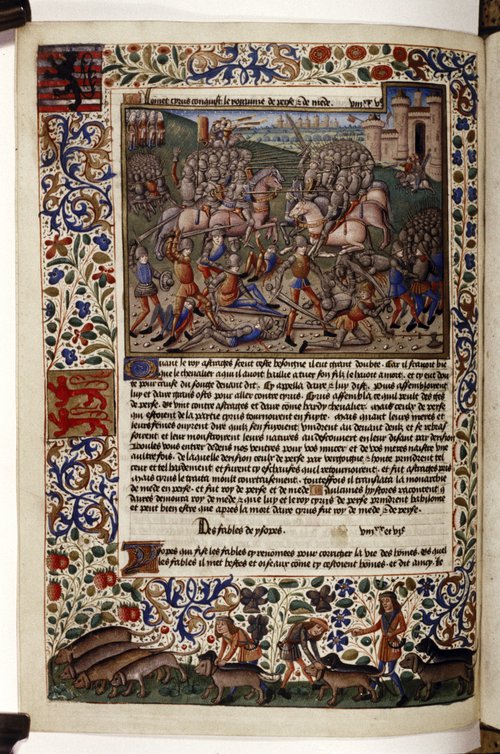
Livre des histoires du miroer du monde: Oxford, Bodleian Library, Douce 336, fol. 74v. © Bodleian Libraries, University of Oxford. Reproduced with CC-BY-NC 4.0.
But, as can be seen in the following excerpt, the divergent version of the Livre des histoires du miroer du monde is more closely related to the Chronique dite de Baudouin d’Avesnes, as is this passage from the Fleur des histoires by Jean Mansel, for example:
Livre des histoires du miroer du monde, Paris, BnF, fr. 684, fol. 70r:
En ce temps estoit Astragés roy de Mede. Il avoit une fille dont il songoit qu’il yssoit d’elle une vigne qui couvroit toute la partie d’Aise. Il compta ceste aux plus sages homme de son royaulme. Ilz luy dirent qu’elle airoit [sic] ung filz, qui seroit roy d’Aussire et le getteroit hors de son regne.
Jean Mansel, Fleur des Histoire, Paris, BnF, fr. 55, fol. 172v:
Au temps de la transmigracion de Babiloine, environ la fin, Astragés estoit roy de Medie. Il avoit une fille dont il songa une nuit que de sa fille issoit une vingne qui couvroit toute la porte d’Asie. Il demanda aux sages que ce songe signefioit. Ilz lui dirent que sa fille avroit ung filz qui seroit roy d’Asie et le bouteroit hors de son royaume.
Of course, as there are interpolations and contaminations between the Chronique dite de Baudouin d’Avesnes and the Manuel, the situation might be even more complex.
This cursory look shows how a serial approach to these texts, while practically difficult, can yield new insights on these often-neglected texts that nevertheless constituted a regular fixture in aristocratic libraries and must have been considered the basis for a general historical culture. We may wonder what these variations mean in relation to the transmission and life of these texts. Should we see in the textual evolutions a reflection of material constraints linked to the copies present in workshops, or on the contrary wishes from possessors and modifications with a specific intent, whether they show an evolution of taste or diverging historical, political and genealogical views?
The road is still long and arduous to answer all these questions and get a better overview of these texts that often survive in several manuscripts and were present in almost every aristocratic library. Even the texts that only survive in single manuscripts are usually massive, and because of the problems described above of diverging versions and similar material, the basic philological work seems to have to be constantly redone and started anew: seeing and studying the manuscripts, encompassing the full scope of their textual traditions, sorting the manuscripts and validating gathered data against previous knowledge, etc. The SSHRC-funded project (2018-2023) that I have launched, H(istoires) U(niverselles) 15, comes from the idea of serializing universal chronicles written in the 15th century in French to gather as many texts as possible and form a corpus that could be manipulated as such (and the list will most certainly grow and evolve over time). Its initial ambition is to bring together in one place up-to-date information on the manuscript traditions of these texts, and start the sorting process by indicating their contents, so that anyone wishing to pursue the work could at least draw on resources that are already gathered, validated and sorted: lists of manuscripts, bibliographies, descriptions, links to references and digitizations, tables of contents, etc. The open-access dimension of the research and its adaptable format (XML-TEI semi-diplomatic transcriptions) are deliberate, in order to allow other scholars to download the data and continue working on these texts that still have much to say, from their views on history, lineage and memory to clues on their readers and possessors, or the book-making process and book market of the 15th century.
Works cited
Jeffrey H. Kaimowitz, “A Fourth Redaction of the Histoire ancienne jusqu'à César”, in Classical Texts and their Traditions. Studies in Honor of C. R. Trahman, eds. David F. Bright and Edwin S. Ramage, Chico [California], Scholars Press 1984, pp. 75–87.
Marigold Anne Norbye, “‘A tous nobles qui aiment beaux faits et bonnes histoires’: The Multiple Transformations of a Fifteenth-Century French Genealogical Chronicle”, in The Medieval Chronicle V, ed. Erik Kooper, Leiden, Brill, 2008, pp. 175–196.
Anne Rochebouet, “De la Terre sainte au val de Loire : diffusion et remaniement de l'Histoire ancienne jusqu'à César au XVe siècle”, in Romania, 134 [2016], pp. 169–203.
Richard Trachsler, “L’Historia regum Britannie au XVe siècle. Les manuscrits New York, Public Library, Spencer 41 et Paris, Bibliothèque de l’Arsenal, 5078”, in L’Historia regum Britannie et les “Bruts” en Europe, I, eds. Hélène Tétrel and Géraldine Veysseyre, Paris, Garnier, 2015, pp. 193–209.
Piotr Tylus, “Un nouveau manuscrit d’un Miroir du monde”, in Romance Philology, 58 [2004], pp. 99-107.